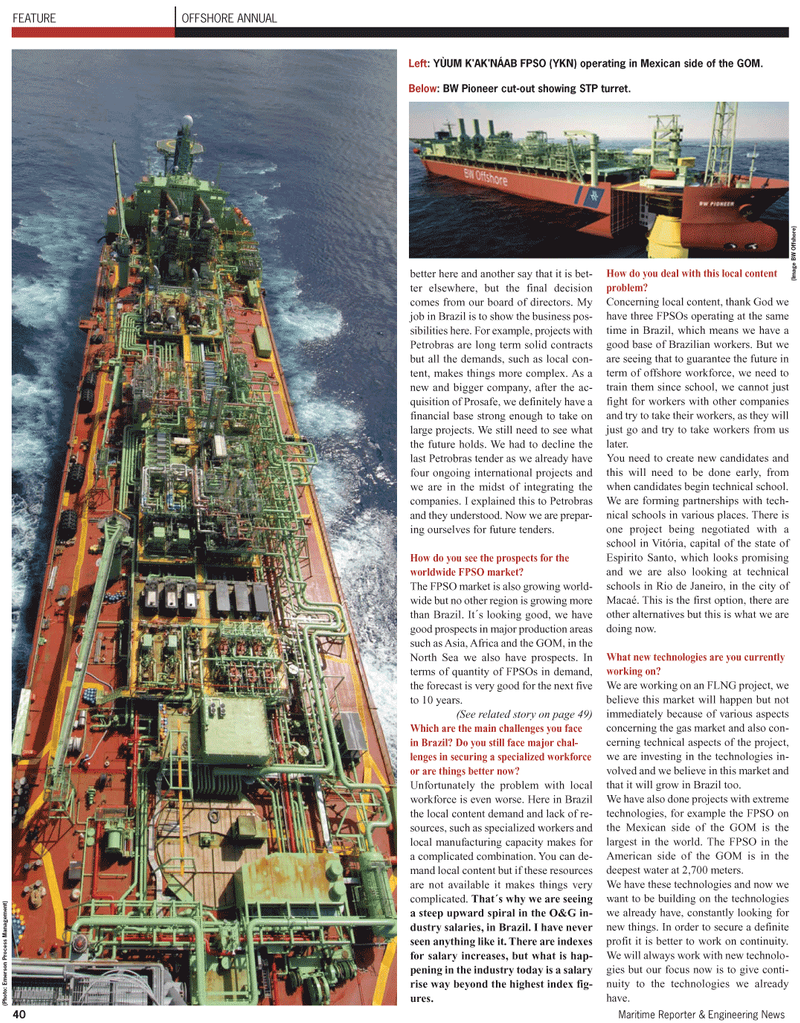
Page 40: of Maritime Reporter Magazine (April 2011)
Offshore Annual
Read this page in Pdf, Flash or Html5 edition of April 2011 Maritime Reporter Magazine
FEATURE OFFSHORE ANNUAL better here and another say that it is bet- ter elsewhere, but the final decision comes from our board of directors. My job in Brazil is to show the business pos- sibilities here. For example, projects with
Petrobras are long term solid contracts but all the demands, such as local con- tent, makes things more complex. As a new and bigger company, after the ac- quisition of Prosafe, we definitely have a financial base strong enough to take on large projects. We still need to see what the future holds. We had to decline the last Petrobras tender as we already have four ongoing international projects and we are in the midst of integrating the companies. I explained this to Petrobras and they understood. Now we are prepar- ing ourselves for future tenders.
How do you see the prospects for the worldwide FPSO market?
The FPSO market is also growing world- wide but no other region is growing more than Brazil. It´s looking good, we have good prospects in major production areas such as Asia, Africa and the GOM, in the
North Sea we also have prospects. In terms of quantity of FPSOs in demand, the forecast is very good for the next five to 10 years. (See related story on page 49)
Which are the main challenges you face in Brazil? Do you still face major chal- lenges in securing a specialized workforce or are things better now?
Unfortunately the problem with local workforce is even worse. Here in Brazil the local content demand and lack of re- sources, such as specialized workers and local manufacturing capacity makes for a complicated combination. You can de- mand local content but if these resources are not available it makes things very complicated. That´s why we are seeing a steep upward spiral in the O&G in- dustry salaries, in Brazil. I have never seen anything like it. There are indexes for salary increases, but what is hap- pening in the industry today is a salary rise way beyond the highest index fig- ures.
How do you deal with this local content problem?
Concerning local content, thank God we have three FPSOs operating at the same time in Brazil, which means we have a good base of Brazilian workers. But we are seeing that to guarantee the future in term of offshore workforce, we need to train them since school, we cannot just fight for workers with other companies and try to take their workers, as they will just go and try to take workers from us later.
You need to create new candidates and this will need to be done early, from when candidates begin technical school.
We are forming partnerships with tech- nical schools in various places. There is one project being negotiated with a school in Vitória, capital of the state of
Espirito Santo, which looks promising and we are also looking at technical schools in Rio de Janeiro, in the city of
Macaé. This is the first option, there are other alternatives but this is what we are doing now.
What new technologies are you currently working on?
We are working on an FLNG project, we believe this market will happen but not immediately because of various aspects concerning the gas market and also con- cerning technical aspects of the project, we are investing in the technologies in- volved and we believe in this market and that it will grow in Brazil too.
We have also done projects with extreme technologies, for example the FPSO on the Mexican side of the GOM is the largest in the world. The FPSO in the
American side of the GOM is in the deepest water at 2,700 meters.
We have these technologies and now we want to be building on the technologies we already have, constantly looking for new things. In order to secure a definite profit it is better to work on continuity.
We will always work with new technolo- gies but our focus now is to give conti- nuity to the technologies we already have.
Left: YÙUM K'AK'NÁAB FPSO (YKN) operating in Mexican side of the GOM.
Below: BW Pioneer cut-out showing STP turret. (Photo: Emerson Pr ocess Management) (Image BW Of fshor e) 40 Maritime Reporter & Engineering News

 39
39

 41
41
